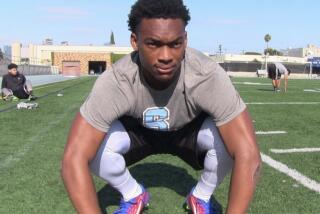Loyola’s Hypolite Chases His Football Destiny
With the lights out, his bedroom door closed and in total silence, George Hypolite contemplated a decision that could have changed his athletic future.
In deep meditation, he weighed the consequences of switching allegiances, from basketball to football.
“Would this hurt me? Would this help me? I was trying to make sure the decision was right,” he recalled.
Hypolite went out for the sophomore football team at Los Angeles Loyola last season, his first year of tackle football.
On Saturday, he found himself playing fullback in the Southern Section Division I semifinal at Home Depot Center. Loyola prevailed, 22-15, in an overtime thriller against defending champion Los Alamitos.
Four times, the Cubs stopped Los Alamitos running back Joshua Jones from the two-yard line. On the last play, linebacker Chris Jauregui put his arms around Jones’ feet at the goal line to prevent him from scoring.
“We went all-out blitz,” Jauregui said. “We just checked our guts and everybody did it.”
Hypolite charged onto the field to celebrate. He finished with 43 yards rushing in eight carries and provided a decisive block during a Trason Bragg touchdown run.
Coach Steve Grady calls Hypolite “a basketball player in a football player’s body.” Hypolite respectfully disagrees.
“I was a football player playing basketball, because when I play basketball, I’m not a finesse player,” he said. “I always had a football player’s mentality but didn’t know it.”
At 6 feet 3 and 245 pounds, with 4.7 40-yard speed and a body that absorbs blows, Hypolite might be the best college prospect on the Loyola roster. And he’s only a junior.
“My future is definitely in football because I’m starting to develop a passion for it,” he said. “It’s becoming soothing. I understand a lot more. Instead of feeling my way, I can anticipate and expect things. It’s poetry in motion when you expect something to happen.”
Hypolite once didn’t know how to put on shoulder pads. His idea of a good block was running over a smaller defender.
“There was things about technique I had to learn,” he said. “I didn’t know how to block, so I’d run the guy over and keep running. You have to realize what play you’re running and what the objective is. There are times you don’t want to kill the guy but just get in front to let the running back through.”
In his early days of football, Hypolite kept asking Loyola’s trainer, Tim Moscicki, if all the bruises he was picking up were normal. He’d have bruises on his thighs, arms, legs. He’d never get bruises in basketball.
“He laughed,” Hypolite said. “It’s part of the game. Basketball is a contact sport and football is a collision sport.”
Hypolite learned in a sophomore game against Pasadena Muir that he could handle himself in football. The free safety came up and greeted him with a smashing hit.
“It woke me up,” Hypolite said. “You have to go as hard as they are coming to you. It taught me you can take hits. Sometimes you have to absorb hits. When I got up, it didn’t hurt.”
Hypolite was a member of last season’s Division I-A championship basketball team at Loyola. He didn’t get on the court in the final at the Pond, but watching Omar Wilkes and Chris Rucker lead the Cubs left a lasting impression.
“I can say I learned how to win,” he said. “I learned it takes a lot of sacrifice during games. There are going to be hard spots, but you have to be ready to perform when challenged.”
Hypolite lives in Ladera Heights with his mother and is glad he made the decision to play football.
“I wanted to prove to myself I could do it,” he said.
He has rushed for 590 yards and scored six touchdowns. He’s still getting used to what must be done when a linebacker tries to tackle him.
“I’m pretty lazy,” he said. “I don’t like running around them.”
Running over them is OK, and he’ll be playing in Friday’s Division I championship game thanks to Jauregui and his defensive pals.
*
Eric Sondheimer can be reached at [email protected]
More to Read
Get our high school sports newsletter
Prep Rally is devoted to the SoCal high school sports experience, bringing you scores, stories and a behind-the-scenes look at what makes prep sports so popular.
You may occasionally receive promotional content from the Los Angeles Times.







